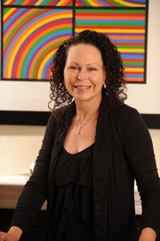
Ms. Kerry Adams Hapner
San Jose: The Arts at the Heart of Economic and Cultural Development
Posted by Jul 12, 2012 0 comments

Ms. Kerry Adams Hapner
Let me begin by saying this: art is at the heart of everything we do. Preserving, advancing, and celebrating culture and expression is our fundamental mission here in San Jose’s Office of Cultural Affairs (OCA).
We strategically position that mission to align with economic development goals, which is authentic to our city’s culture and climate, benefits the sector and enables us to advance our core mission. I don’t have that “intrinsic” versus “instrumental” debate; intrinsic impact is a foregone conclusion for me and the economic benefits enable strategic alignment, a.k.a. partnerships and resources.
In San Jose, the OCA is a division of the Office on Economic Development. I am both the Director of Cultural Affairs and a Deputy Director of Economic Development. Recognizing that a vibrant community attracts talent, and talent attracts companies, our economic development strategy fosters the vital cycle between cultural development (the arts), workforce development (the people), and business development (the companies).
We fulfill our cultural development goals through three primary strategies: attracting and retaining destination quality events; promoting high quality public art and placemaking; and providing arts industry support.
We foster the arts industry through nonprofit grants and support, cultural facility management, and support for creative entrepreneurs—comprised of artists and the commercial creative sector. Each function has its inherent, intrinsic cultural value—celebrating heritage, creativity, and the arts. And yet, we celebrate and amplify the economic side of these functions—culture as a catalyst for business through the nonprofit and commercial industries.It is also a means of building a sense and brand of place, a magnet to attract other industries.
We’ve advanced greatly by using tools that allow us to calculate the economic impact of the nonprofit sector and the number of creative industries. This is so important so we can emphasize why we need to support and sustain the arts.
The San Jose Sharks hockey team generates $65 million in annual economic impact. The nonprofit arts sector generates $122 million!
I am encouraged and excited by the ability to be Counting New Beans by measuring the intrinsic impact of the arts (thanks to Alan Brown and Theatre Bay Area for advancing this work). We need many tools in the bag that can advance our mission.
In San Jose, the capital of Silicon Valley, we are a business-centric city. With the highest number of U.S. patents registered here, we truly are an innovation economy. We are hearing more and more from CEO’s and business leaders that they are choosing San Jose and our downtown in particular because of the sense of place. It is not only a place to network, but a place with vibrancy and a thriving cultural scene.
San Jose’s investment in its downtown theaters, museums, cultural facilities, and public art has enabled it to reflect its new position in the world as the center of Silicon Valley. It gives a physical manifestation to the innovation that happens here.
We have experienced major transformation in the last five years that has us all redefining “The New Normal." Major forces of change have included the Great Recession and its many economic complexities, demographic shifts, and in California, the loss of redevelopment agencies, which utilized a tax increment tool to redevelop blighted areas.
In California, with the loss of redevelopment agencies, partnerships and shared solutions between local government and the community are increasingly paramount. As an example, in San Jose, creative placemaking is becoming a shared value by our downtown association, property owners, businesses, arts organizations, philanthropic foundations, residents, and civic leaders.
The heart of the question (and I would love to hear from you):
How do we foster increased ownership of our civic spaces and places to facilitate a unique, authentic creative urban culture that is good for cities, partners, and the biz and buzz of culture?

